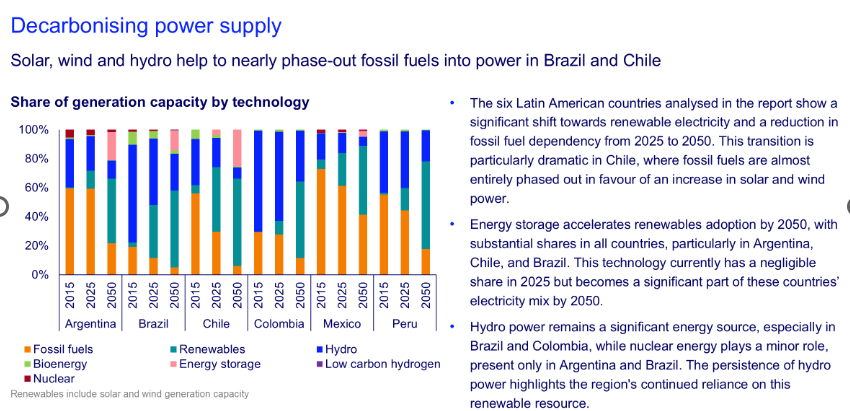
Latin America's Top Economies Raise the Game in Renewable Power
Published by Todd Bush on July 10, 2025
Nearly 70% of electricity comes from renewables, which is about 60% more than the global average
According to the “Benchmarking Latin America energy markets” report from Wood Mackenzie, Latin America is making progress in reducing its carbon emissions and adopting more sustainable energy sources. However, it still has a long way to go to meet global climate goals.
The analysis focuses on the six largest economies in the region by GDP that have more noticeable advances in this field: Brazil, Mexico, Argentina, Colombia, Chile and Peru. Gerado Bocard, research analyst at Wood Mackenzie, said, “These countries share broad structural similarities: reliance on fossil fuels and minerals exports, increasing urbanisation, and growing energy demand.”
>> In Other News: RNG Coalition welcomes One Big Beautiful Act
Fossil fuels: Where there’s room to grow
Fossil fuels remain an important source of energy; however, the selected countries have been working on reducing their dependence on them. Brazil is leading this commitment, and it’s expected to drop its use to 49% by 2050; Mexico remains heavily reliant on fossil fuels with its share declining modestly from 95% to 86% by 2050.
Renewable energy sources bring high expectations
Chile has made significant progress in renewable energy sources, which accounted for 70% of its electricity by the end of 2024; positioning it as a leader in clean energy adoption across Latin America. Some countries, such as Brazil and Colombia, have expanded the use of hydro power, while nuclear energy plays a minor role, present only in Mexico, Argentina and Brazil. Across the region, solar, wind, and biofuels are seeing a significant increase, harnessing rich natural resources.

The promise of green hydrogen and CCUS
Across the region there are 167 low-carbon hydrogen, and 58 carbon capture, utilisation and storage (CCUS) projects announced. Brazil is leading with 43 projects, including 24 Mt CCUS capacity in operation and 11.5 Mt under development. Latin America is experiencing a surge in green hydrogen initiatives at different phases of progress. Currently, 82 projects are actively running, predominantly in Chile, Brazil, and Argentina. Additionally, numerous other projects have been declared and are at various stages of advancement throughout the region.
These developments highlight the diverse approaches taken by different countries in the region. Bocard commented, “We can see how some of these countries obtain benefits from larger domestic markets while others rely on external influences such as import and export for different commodities.” He added, “However, despite the progress, there's still work to be done to have a sustainable and resilient energy future, collaborative efforts, targeted policies and investments will be crucial in achieving net-zero goals.”
Subscribe to the newsletter
Daily decarbonization data and news delivered to your inbox
Follow the money flow of climate, technology, and energy investments to uncover new opportunities and jobs.
Latest issues
-
How 45Q Credits Revived This Troubled $9B Megaproject
Inside This Issue 💰 How 45Q Credits Revived This Troubled $9B Megaproject 🍁 Commencement of First Phase Operations for a Carbon Capture and Storage (CCS) Project in Canada 🤝 Haffner Energy Secures...
-
The Deal Structure Everyone's About to Copy
Inside This Issue 💼 The Deal Structure Everyone's About to Copy 📈 Exxonmobil Raises Its 2030 Plan – Transformation Delivering Higher Earnings, Stronger Cash Flow, and Greater Returns ⚡ Nextera Wor...
-
Inside XCF Global's $300M Bet to Double U.S. SAF Output
Inside This Issue ✈️ Inside XCF Global's $300M Bet to Double U.S. SAF Output ⚙️ Capsol Technologies Signs MoU with US Utility to Deploy CapsolGT® for Low-carbon Gas Power Generation 🏭 Babcock &...
Company Announcements
-
Clean Planet Technologies (CPTech), part of the Clean Planet Group, has announced that its core pyrolysis-oil upgrading process has now been formally patented in both the United States and Saudi Ar...
-
(December 12, 2025 - Oslo, Norway) Nel ASA (Nel, OSE: NEL) is pleased to announce that following a seven-year development program, and now a successful start-up and production of clean hydrogen on ...
-
Hydrogen Technology Venture Launches in Bowling Green
BOWLING GREEN, Ky. — A new tech company is coming to Bowling Green, bringing dozens of jobs to Warren County. What You Need To Know UFS ARK will be a joint venture of United Fiber Sensing and OgM...
-
HyOrc Positions Green Methanol as the Economic Solution to Shipping’s Decarbonization Challenge
HOUSTON, Dec. 12, 2025 (GLOBE NEWSWIRE) -- HyOrc Corporation (OTCID: HYOR), a fully SEC-reporting clean-energy company focused on decarbonizing heavy industry, today commented on the growing global...